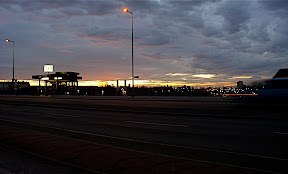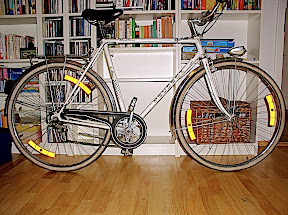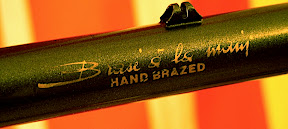skip to main |
skip to sidebar
 The Batavus started out as a bike for my wife who had muttered interest in cycling with me. The idea took form when I won an auction for the Batavus frame for €35. I didn't realise that it was made from Columbus SLX tubing until I collected it. The guy selling didn't show much enthusiasm for the frame, he'd had built up as a speed-bike with a threadless alu-fork. On closer inspection all sorts of beautiful details on the frame caught my eye. The Cinelli BB-shell (with spoiler), the inner tube for the back brake, stainless faces on the dropouts (technociclio) and engraved topeyes and brake bridge. If you run your finger inside the tubes around the BB you can feel the helical reinforcement pressed into the butts of the tubes.The first problem was to find a suitable fork and the typically the last place I tried, my local bike shop (LBS) "Radhaus Wedding" just up the street, had one that fit. What's more they gave me a present of it. Problem was some knobhead had painted it although it was chromed underneath and what's worse he (I'm assuming a man did this, no woman could be so stupid) sanded the surface of the chrome. Luckily he got bored quickly and only sanded the top half and luckily the paint didn't adhere to the chrome very well and came off easily with an electric heat gun which "Radhaus Wedding" lent me. When it was all cleaned I realised it was no ordinary chrome fork. Firstly it was very light, had an emblem with "R" in the middle and the steerer had the same helical reinforcement so it had to have either Columbus SL or perhaps even SLX blades made by the legendary italien framebuilder Rauler.The next problem was that the fork steerer was too short for most headsets so I spent a week or two comparing the stack heights of any headset I might have been able to get my hands on.Tange threaded cartridge headsets have the lowest stack height on the market and if you can find a thinner washer to go with the set you could reduce the height a futher mm or so.Once that was solved the hunt was on for the rest of the components and some €600 later I had a gorgeous bike set-up for much more that I had initially planned.So why so expensive? Well most of the parts were NOS and the normal conaumable; tyres, tubes, cables, housing all add up.The last part that I put on was the chain and I had never used a 9-speed chain before. In my ignorance I broke the stud that came with the chain as my chain tool was too clumsy. One whole week the bike was almost built-up and the chain problem was stopping me trying it out. At last I swallowed my pride, took it the bike shop, and let them sort out the chain which I had somehow cut too short. The mechanic asked me if I usually ride 53/23. I said know and we left it at that.
The Batavus started out as a bike for my wife who had muttered interest in cycling with me. The idea took form when I won an auction for the Batavus frame for €35. I didn't realise that it was made from Columbus SLX tubing until I collected it. The guy selling didn't show much enthusiasm for the frame, he'd had built up as a speed-bike with a threadless alu-fork. On closer inspection all sorts of beautiful details on the frame caught my eye. The Cinelli BB-shell (with spoiler), the inner tube for the back brake, stainless faces on the dropouts (technociclio) and engraved topeyes and brake bridge. If you run your finger inside the tubes around the BB you can feel the helical reinforcement pressed into the butts of the tubes.The first problem was to find a suitable fork and the typically the last place I tried, my local bike shop (LBS) "Radhaus Wedding" just up the street, had one that fit. What's more they gave me a present of it. Problem was some knobhead had painted it although it was chromed underneath and what's worse he (I'm assuming a man did this, no woman could be so stupid) sanded the surface of the chrome. Luckily he got bored quickly and only sanded the top half and luckily the paint didn't adhere to the chrome very well and came off easily with an electric heat gun which "Radhaus Wedding" lent me. When it was all cleaned I realised it was no ordinary chrome fork. Firstly it was very light, had an emblem with "R" in the middle and the steerer had the same helical reinforcement so it had to have either Columbus SL or perhaps even SLX blades made by the legendary italien framebuilder Rauler.The next problem was that the fork steerer was too short for most headsets so I spent a week or two comparing the stack heights of any headset I might have been able to get my hands on.Tange threaded cartridge headsets have the lowest stack height on the market and if you can find a thinner washer to go with the set you could reduce the height a futher mm or so.Once that was solved the hunt was on for the rest of the components and some €600 later I had a gorgeous bike set-up for much more that I had initially planned.So why so expensive? Well most of the parts were NOS and the normal conaumable; tyres, tubes, cables, housing all add up.The last part that I put on was the chain and I had never used a 9-speed chain before. In my ignorance I broke the stud that came with the chain as my chain tool was too clumsy. One whole week the bike was almost built-up and the chain problem was stopping me trying it out. At last I swallowed my pride, took it the bike shop, and let them sort out the chain which I had somehow cut too short. The mechanic asked me if I usually ride 53/23. I said know and we left it at that. Outside the shop I just curved around a little on the pavement and instantly fell in love with the bike. Having cycled some 5000km on this bike I now know why I love it so much. It has a very competetive geometry with a long top-tube 555mm and a relatively short seat-tube 530mm. Thus the headtube is proportionatly short. This along with the SLX-tubing and Cinell BB-shell makes the bike rock solid. Astonishingly it still is very comfy and makes fun out cobblestone of which we have our fair share here.This is my fastest bike to date and last summer it demostrated amazing climbing capabilities against fit guys on the best CF money can buy.My wife cycled it once and decided a racing bike is not her thing.
Outside the shop I just curved around a little on the pavement and instantly fell in love with the bike. Having cycled some 5000km on this bike I now know why I love it so much. It has a very competetive geometry with a long top-tube 555mm and a relatively short seat-tube 530mm. Thus the headtube is proportionatly short. This along with the SLX-tubing and Cinell BB-shell makes the bike rock solid. Astonishingly it still is very comfy and makes fun out cobblestone of which we have our fair share here.This is my fastest bike to date and last summer it demostrated amazing climbing capabilities against fit guys on the best CF money can buy.My wife cycled it once and decided a racing bike is not her thing.
 The most limiting factor of commuting has to be the winter darkness. On the 21st of December in Berlin the sun rises shortly after eight and has set again by 4. I work an 8 1/2 hour day with at least an hour's commute each way so that in the deepest winter the whole journey is done in the dark. For over 15 km of my commute there is no street lighting and since I didn't have any decent lighting until last week I had to time my cycle so that the sun was up just enough to navigate this part of the journey. I've had a number of battery-powered lights and they've all been hopeless, the biggest problem being the cold. The batteries seem fine for 20 mins and after it just gets worse and worse. I realised the only practical option would be a dynohub. I'd heard so much about the Schmidt SON dynamos but just couldn't afford a new one so I went for Shimano's 3N71. The time seemed right to get new lighting looking at the newest generation of LED lights that came on the market end of 2007. Amongst these the Busch & Müller' Lumotec IQ Fly seemed the best value so went out and got one to go with my new dynamo.
The most limiting factor of commuting has to be the winter darkness. On the 21st of December in Berlin the sun rises shortly after eight and has set again by 4. I work an 8 1/2 hour day with at least an hour's commute each way so that in the deepest winter the whole journey is done in the dark. For over 15 km of my commute there is no street lighting and since I didn't have any decent lighting until last week I had to time my cycle so that the sun was up just enough to navigate this part of the journey. I've had a number of battery-powered lights and they've all been hopeless, the biggest problem being the cold. The batteries seem fine for 20 mins and after it just gets worse and worse. I realised the only practical option would be a dynohub. I'd heard so much about the Schmidt SON dynamos but just couldn't afford a new one so I went for Shimano's 3N71. The time seemed right to get new lighting looking at the newest generation of LED lights that came on the market end of 2007. Amongst these the Busch & Müller' Lumotec IQ Fly seemed the best value so went out and got one to go with my new dynamo.  I mounted the light on a piece of right angled steel directly on to the quick-release skewer so I can easily swap the wheel-lamp combination back and forth with other wheels.The first time I rode with the lamp the only thing I could say was boah!The IQ Fly outputs extremely bright, white light in three beams. The centermost and most intensive building a block of light 5m in front of the bike, bright enough to take in every detail even at 30km/h. The narrower beam lights up details like trees at a distance of 100m. The white light reflects intensively off reflective surfaces like signs but more usefully the reflective linings on jogger's clothing.The Shimano 3N71 is also very recommendable. There is a noticeable resistance when the light is on but it varies. At it's strongest it feels like a slight climb. Laced up with a Mavic Open 4CD it has made a beutifully stiff, well handling wheel and the extra weight at the front seems to suit my "Batavus Professional" very well.
I mounted the light on a piece of right angled steel directly on to the quick-release skewer so I can easily swap the wheel-lamp combination back and forth with other wheels.The first time I rode with the lamp the only thing I could say was boah!The IQ Fly outputs extremely bright, white light in three beams. The centermost and most intensive building a block of light 5m in front of the bike, bright enough to take in every detail even at 30km/h. The narrower beam lights up details like trees at a distance of 100m. The white light reflects intensively off reflective surfaces like signs but more usefully the reflective linings on jogger's clothing.The Shimano 3N71 is also very recommendable. There is a noticeable resistance when the light is on but it varies. At it's strongest it feels like a slight climb. Laced up with a Mavic Open 4CD it has made a beutifully stiff, well handling wheel and the extra weight at the front seems to suit my "Batavus Professional" very well.
 The scoop of the week was a 1981 Peugeot PE41M from a well known online auction house for €25. The bike is well used but in good working order and should get me through the winter. I had hoped it would have 650B (ETRTO 584 or 26 1/2") size wheels but sadly they're 28". It seems this model came with both. The dimples on the back fork of this model are definetely not designed for 28". The brakes however don't seem to have enough reach for a smaller rim.
The scoop of the week was a 1981 Peugeot PE41M from a well known online auction house for €25. The bike is well used but in good working order and should get me through the winter. I had hoped it would have 650B (ETRTO 584 or 26 1/2") size wheels but sadly they're 28". It seems this model came with both. The dimples on the back fork of this model are definetely not designed for 28". The brakes however don't seem to have enough reach for a smaller rim.
My plan was to turn this bike into a single speed but I'll leave it as it is it works just fine as 5-speed and has a certain novelty about it. It's nice to have a bike again that's "Verkehrstauglich" road-fit by german law (a lot of nonsense for the most part). It has a bell, reflectors, lights that work and two brakes.
What more could you want?
Phelim
This might not be everyone's cup of tea as a means of getting to work. I think most Berliners and Potsdamers aren't aware of cycling this route as an alternative to the train or car. It's also a great way for tourists to visit Potsdam by bike. You might be asking why should I cycle to Potsdam when I could travel by train with my bike for €10 return. The answer is because it's worth the effort, it doesn't take much longer and you can have a nice lunch in Potsdam with the €10 you saved. In the coming year I'll post impressions of the commute as it changes throughout the seasons and present the numerous highlights along the way. Such as the Glienicker Brücke (photo right by Gunnar Neitz).The map below shows the 33km route from where I live in Wedding to where I work (Telegrafenberg) in Potsdam. However there are numerous detours you can take dpending on what kind of a bike you're on. I vary my route regularly. Größere Kartenansicht I hope you'll stay tuned for further episodes as the year progresses.
In the coming year I'll post impressions of the commute as it changes throughout the seasons and present the numerous highlights along the way. Such as the Glienicker Brücke (photo right by Gunnar Neitz).The map below shows the 33km route from where I live in Wedding to where I work (Telegrafenberg) in Potsdam. However there are numerous detours you can take dpending on what kind of a bike you're on. I vary my route regularly. Größere Kartenansicht I hope you'll stay tuned for further episodes as the year progresses.Phelim
 My New Year's resolution ... get my Blog going!
My New Year's resolution ... get my Blog going!
welcome to my blog. In Summer 2007 I set out to build a bicycle frame. My goal was to have it started by the end of the year and instead I'm now almost finished my first frame. The first bike is going to be a steel track bike for the road.
Framebuilding has turned out to be everything I expected and more. I have always been interested in mechanical engineering and learned draughtsmanship after leaving school. I quit unfortunately and took up a job digitizing maps which got me into geoinformatics and IT which is what I do now at GFZ.
I've loved bikes since I got my first one at the age of five but my interest has ebbed during certains stages of my life. Since I started commuting to Potsdam over 2 years ago I must admit I've become addicted to cycling and everything surrounding it.
I was inspired to the idea of framebuilding by two frames I bought in 2006. The first, a Peugeot from the late eighties is made from Reynolds 753r tubing and had the words "Hand Brazed" on the crossbar.

It seems strange now but until then I'd never asked myself how frames are made.
A real inspiration was Suzy Jackson's Tutorial on "Bicycle frame building for the rest of us".
I'd like to encourage anybody who's thinking of building a bicycle frame to just go for it.
The idea of this blog collect and present the resources and constraints relevant to building bicycle frames in Germany. I am in no manner an expert in this field but the information about framebuilding in Germany is spread across a dozen of forum threads. My goal is to digest it and spew it up here for your degustation.

